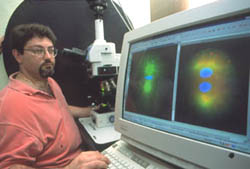by Chris Bryant

It’s a tiny worm, so small you need a microscope to see it. But in the laboratory of Dr. Guy Caldwell, the worm may be poised to reveal some big secrets, giving scientists better insight into various neurological diseases.
Caldwell, an assistant professor of biological sciences at The University of Alabama, uses the worm, a microscopic nematode known as C. elegans, in his research into the debilitating diseases, dystonia and lissencephaly.
Children born with lissencephaly have smooth brains rather than brains with multiple ridges and valleys. They suffer from severe mental retardation and epileptic seizures and often die by the age of two.
Dystonia is a movement disorder that can cause repetitive, painful, spasms. It can affect one or many parts of the body and can cause loss of speech and an inability to walk. Six times more prevalent than Huntington’s Disease or muscular dystrophy, dystonia is said to affect more than 300,000 people in North America.
There are no known cures or preventatives for either disease, but there is hope. That hope lies, primarily, in genetic research done by those like Caldwell.
Caldwell uses C. elegans to gain a better understanding of the diseases at the molecular level. Learning more about gene function is the first step toward developing more effective drugs and countermeasures.
Greater than 50 percent of all human hereditary diseases, including lissencephaly and dystonia, have been linked to genetic components also found in C. elegans, Caldwell said. “This animal’s nervous system has been completely mapped and contains only 302 neurons, in contrast to the 100 billion neurons located in the human brain, alone,” Caldwell said. This makes it easier to trace the pathways of the worm’s neurons and trace its protein functions within the neurons and related cells. “All the typical hallmarks of the human nervous system are present in this worm. It also has rapid responses which, since it’s transparent, can be easily examined, and it allows you to identify additional genes that may be involved in a similar process.”
Three of the worms’ genes, including two first identified by Caldwell, have been directly linked to the human dystonia gene. The Dystonia Medical Research Foundation funded a pilot study by the UA team and recently invited Caldwell to apply for additional support given his excellent preliminary progress.
The March of Dimes Birth Defects Foundation has also noted Caldwell’s work. Earlier this year the group named him a Basil O’Connor Scholar. The only researcher in the Southeast so designated, Caldwell’s honor was accompanied by $150,000 in funding from the March of Dimes to continue his research into lissencephaly. Created “to help some of the nation’s most promising young scientists commit to careers in birth defects research,” the honor in previous years went to future Nobel Prize winners and the head of the National Genome Research Institute.
The UA professor’s research has the potential to provide insight into other neurological disorders such as epilepsy, Alzheimer’s disease and tumors of the brain.
“We can now create worms that have epileptic seizures in our lab,” Caldwell said. “If we can deduce the specific defect, hopefully, we can go in and find things that will cure it, either genetically or chemically.”
Lissencephaly occurs when the neurons in the brain are not properly migrating, Caldwell said. “The disease is caused by a network of genes that researchers don’t really have an understanding of how they work,” Caldwell said. “By understanding where and when these genes are turned on and which other genes they interact with in this animal, we can answer questions about how they function. Molecular answers lead to molecular cures — like drugs.”
Caldwell, who joined UA’s biology faculty in 1999 following postdoctoral training at Columbia University, incorporates his research into the classroom, in particular within the Integrated Genetics class he teaches. In that class, made possible by a $1.6 million Howard Hughes Medical Institute grant, the students learn how to grow and manipulate C. elegans. They also learn how to identify the worm’s genetic features, using research microscopes linked to computers to provide digital imaging for photo documentation. In addition, four graduate students and four undergraduate students are research assistants in the laboratory with Caldwell and his wife, Dr. Kim Caldwell, an adjunct assistant professor at UA.
Caldwell said he hopes genetic research, and the tiny worm it revolves around, will one day make a big difference in the lives of people affected by these devastating diseases. “I really do believe we can help.”